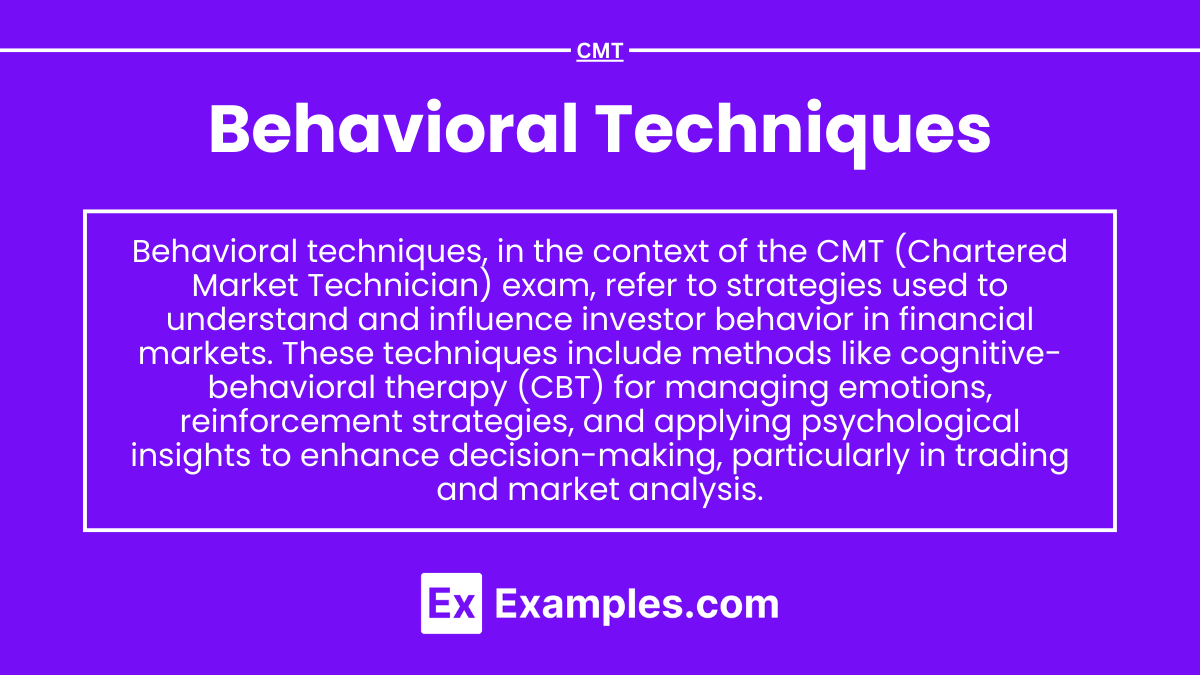Behavioral Techniques focus on understanding the psychological factors that influence market behavior, recognizing that markets are driven not only by data but also by human emotion and cognitive biases. This topic delves into concepts like herd behavior, overconfidence, and loss aversion, examining how these and other biases affect investor decision-making and market trends. Behavioral techniques provide insights into the psychological underpinnings of price movements, allowing analysts to interpret anomalies and anticipate reactions under various market conditions. Mastery of these concepts enhances the technical analyst’s ability to incorporate behavioral insights into trend analysis and trading strategies.
Learning Objectives
In studying “Behavioral Techniques” for the CMT, you should learn to understand the psychological factors that influence investor behavior, including cognitive biases such as overconfidence, anchoring, and loss aversion. Analyze how these biases affect decision-making in financial markets and contribute to market anomalies. Examine behavioral finance concepts like herd behavior, framing effects, and mental accounting, and evaluate their implications for price trends and trading patterns. Develop strategies for identifying when behavioral biases may be impacting market movements and learn techniques to minimize their influence on your own analysis. Additionally, explore methods for integrating behavioral insights into technical analysis to enhance market predictions and improve trading outcomes.
Understanding Psychological Factors Influencing Investor Behavior
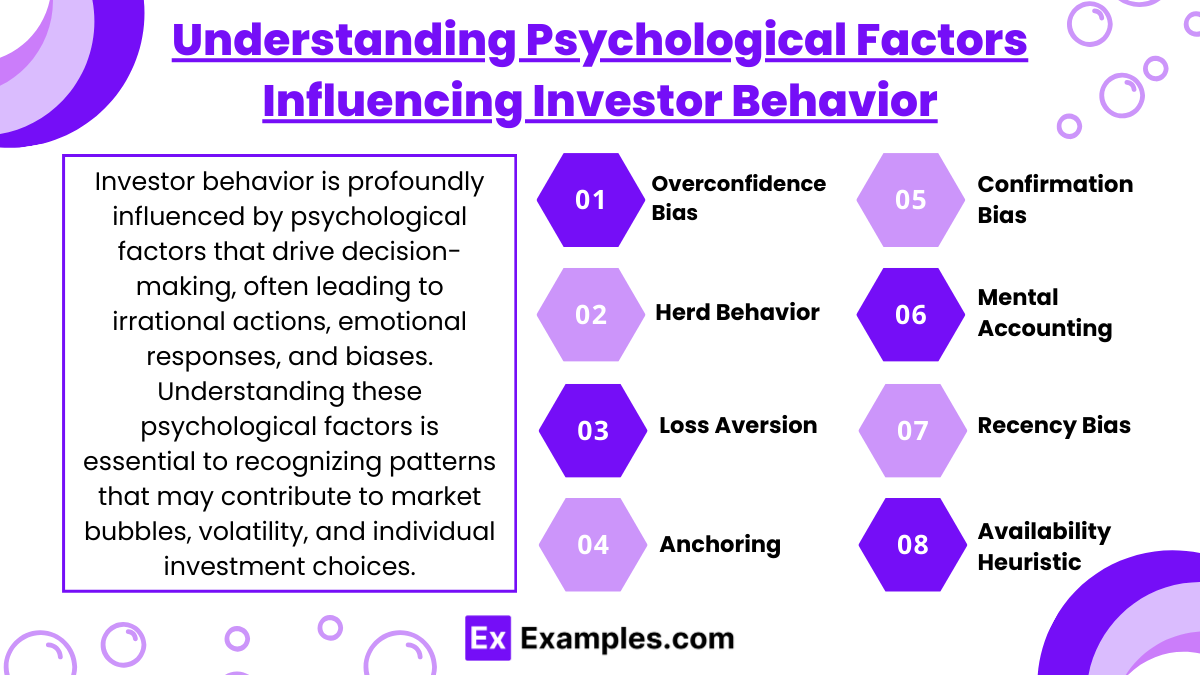
Investor behavior is profoundly influenced by psychological factors that drive decision-making, often leading to irrational actions, emotional responses, and biases. Understanding these psychological factors is essential to recognizing patterns that may contribute to market bubbles, volatility, and individual investment choices. Here are some key psychological factors that influence investor behavior:
1. Overconfidence Bias
- Definition: Overconfidence bias occurs when investors overestimate their knowledge, abilities, or predictions about the market.
- Impact on Behavior: Overconfident investors may take excessive risks, trade more frequently, and hold under-diversified portfolios, believing their insights are superior.
- Example: An investor may buy heavily into a hot stock, convinced they have unique insight into its potential, disregarding other factors or risks.
2. Herd Behavior
- Definition: Herd behavior is the tendency to mimic the actions of a larger group, often out of fear of missing out (FOMO) or due to the perception that the group’s behavior is rational.
- Impact on Behavior: Investors may follow market trends without individual analysis, which can drive prices up during bubbles and accelerate sell-offs during downturns.
- Example: During a speculative bubble, herd behavior can lead to mass buying, inflating asset prices far beyond fundamental value.
3. Loss Aversion
- Definition: Loss aversion is the tendency to prefer avoiding losses rather than achieving equivalent gains, as losses are psychologically more painful than gains are pleasurable.
- Impact on Behavior: Investors may hold onto losing investments for too long, hoping to recoup losses, or avoid selling at a loss, even when it would be prudent.
- Example: An investor may refuse to sell a stock that’s declining, hoping it will recover, even if better investment opportunities are available.
4. Anchoring
- Definition: Anchoring involves placing too much reliance on an initial piece of information or “anchor” when making decisions, even if new information suggests otherwise.
- Impact on Behavior: Investors might base decisions on a past stock price or their original purchase price, leading to suboptimal choices as they ignore changing market conditions.
- Example: If an investor bought a stock at $50, they may anchor to this price, refusing to sell if the stock drops, regardless of current market data.
5. Confirmation Bias
- Definition: Confirmation bias is the tendency to seek out information that supports pre-existing beliefs or hypotheses, while disregarding contradictory evidence.
- Impact on Behavior: This can lead investors to overlook critical information, focusing only on data that confirms their assumptions about an asset.
- Example: An investor bullish on a company may ignore warning signs about its financial health and focus only on positive news.
6. Mental Accounting
- Definition: Mental accounting is the practice of compartmentalizing money based on its origin, purpose, or intended use, rather than treating all funds as fungible.
- Impact on Behavior: Investors may make inconsistent or irrational choices by mentally assigning different levels of risk to different “accounts” of their money.
- Example: An investor may treat a tax refund as “extra money” and invest it in a riskier asset, disregarding overall portfolio risk.
7. Recency Bias
- Definition: Recency bias is the tendency to place greater importance on recent events or trends, assuming they will continue in the future.
- Impact on Behavior: Investors may buy assets that have recently appreciated, expecting trends to persist, or panic during downturns, fearing continued losses.
- Example: After a stock’s price surge, an investor might buy in, assuming momentum will continue, rather than considering longer-term historical data.
8. Availability Heuristic
- Definition: The availability heuristic is a mental shortcut where investors rely on readily available information rather than conducting comprehensive analysis.
- Impact on Behavior: This can lead to decision-making based on recent news or memorable events, often leading to bias and distortion of actual probabilities.
- Example: Following a well-publicized market crash, an investor might overestimate the likelihood of another crash and invest too conservatively.
Impact of Cognitive Biases on Decision-Making and Market Anomalies
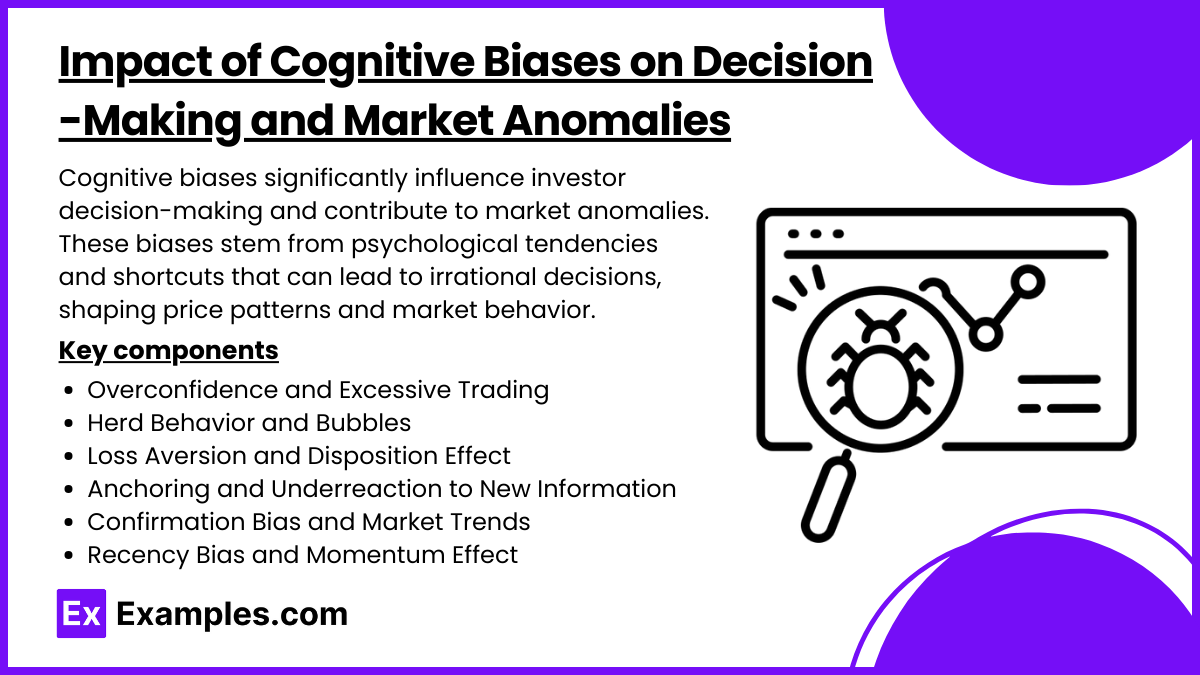
Cognitive biases significantly influence investor decision-making and contribute to market anomalies. These biases stem from psychological tendencies and shortcuts that can lead to irrational decisions, shaping price patterns and market behavior. When many investors act based on these biases, their behavior collectively can create mispricings, bubbles, and crashes in financial markets. Here’s a closer look at how cognitive biases impact decision-making and lead to market anomalies:
1. Overconfidence and Excessive Trading
- Bias: Overconfidence bias causes investors to overestimate their ability to predict market movements, leading to excessive trading.
- Impact on Decision-Making: Investors may trade too frequently, believing in their skills and knowledge, often without sufficient evidence. This increases transaction costs, lowers returns, and can amplify market volatility.
- Market Anomaly: Studies show that frequent traders, especially retail investors, often underperform. Overconfidence contributes to market anomalies such as high trading volumes in bull markets and speculative bubbles as investors flock to “hot” assets.
2. Herd Behavior and Bubbles
- Bias: Herd behavior occurs when investors follow the crowd rather than making independent analyses.
- Impact on Decision-Making: Investors might buy or sell assets simply because others are doing so, fearing missing out or experiencing losses if they don’t follow.
- Market Anomaly: Herd behavior is a significant factor in the formation of bubbles and crashes. During a bubble, prices are driven far above intrinsic value due to collective buying, only to plummet when the crowd rushes to sell, resulting in anomalies like speculative bubbles (e.g., the dot-com bubble or the housing bubble).
3. Loss Aversion and Disposition Effect
- Bias: Loss aversion causes people to feel the pain of losses more intensely than the pleasure of gains.
- Impact on Decision-Making: This bias leads to the disposition effect, where investors hold onto losing assets to avoid realizing a loss, while selling winning assets too quickly to “lock in” gains.
- Market Anomaly: Loss aversion can lead to underpricing of undervalued stocks because investors may avoid selling at a loss. Conversely, the frequent sale of winners can contribute to a momentum anomaly, where stocks that have recently performed well continue to do so in the short term as investors take profits.
4. Anchoring and Underreaction to New Information
- Bias: Anchoring occurs when investors fixate on an initial piece of information or a reference point, such as a past stock price, when making decisions.
- Impact on Decision-Making: Anchoring can lead to underreaction, as investors may be slow to adjust their views and valuations based on new information, relying too heavily on historical prices.
- Market Anomaly: This contributes to the “post-earnings announcement drift” anomaly, where stocks continue to move in the direction of an earnings surprise long after the announcement, as investors gradually adjust their expectations.
5. Confirmation Bias and Market Trends
- Bias: Confirmation bias leads investors to seek information that supports their existing beliefs, ignoring contradictory data.
- Impact on Decision-Making: This bias can lead to selective perception, where investors view positive news as confirmation of a stock’s potential while dismissing negative indicators.
- Market Anomaly: Confirmation bias can drive trends and bubbles as investors pile into assets that align with popular narratives, ignoring risks. This bias also explains why some stocks, like those in high-growth industries, stay overvalued, as investors continue to find evidence to justify high prices.
6. Recency Bias and Momentum Effect
- Bias: Recency bias makes investors focus on recent events, assuming they will continue into the future.
- Impact on Decision-Making: Investors may chase recent winners, believing recent performance is indicative of future returns, leading them to buy assets after significant price rises.
- Market Anomaly: Recency bias drives the momentum effect, where assets that have performed well continue to rise as more investors buy in. This anomaly often leads to overvaluation in the short term, followed by a correction when the trend reverses.
Key Behavioral Finance Concepts and Their Market Implications
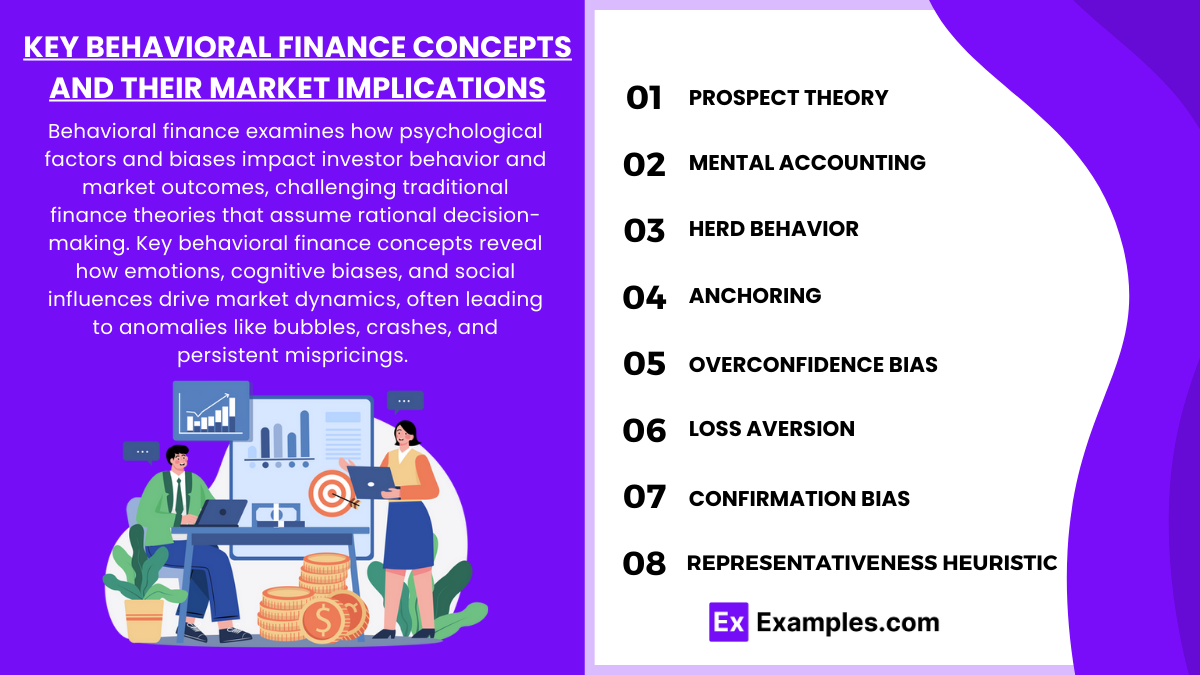
Behavioral finance examines how psychological factors and biases impact investor behavior and market outcomes, challenging traditional finance theories that assume rational decision-making. Key behavioral finance concepts reveal how emotions, cognitive biases, and social influences drive market dynamics, often leading to anomalies like bubbles, crashes, and persistent mispricings. Here are some essential concepts in behavioral finance and their implications for markets:
1. Prospect Theory
- Concept: Proposed by Daniel Kahneman and Amos Tversky, prospect theory suggests that people value gains and losses differently. Specifically, people experience the pain of losses more intensely than the pleasure of equivalent gains, known as “loss aversion.”
- Market Implications: Loss aversion can lead to the disposition effect, where investors hold onto losing assets too long, hoping for a rebound, and sell winning assets too early to “lock in” gains. This behavior can cause underperformance and create price distortions, as undervalued assets remain held while overvalued assets are sold off prematurely.
2. Mental Accounting
- Concept: Mental accounting refers to the tendency to compartmentalize money into different “accounts” based on subjective criteria, like the source of the funds or intended purpose, rather than treating all money as fungible.
- Market Implications: Mental accounting can lead to irrational spending and investment choices. For instance, people may take on excessive risk with “house money” (profits or windfalls) while being overly conservative with their initial capital. In investing, this can result in inefficient portfolio allocations and increased market volatility as investors treat gains differently from other funds.
3. Herd Behavior
- Concept: Herd behavior is the tendency to follow the actions of the larger group, often ignoring personal judgment or available information. This behavior is driven by the fear of missing out (FOMO) and the belief that the crowd is acting rationally.
- Market Implications: Herd behavior can amplify market trends, leading to speculative bubbles when investors collectively buy into an overvalued asset or market crashes when panic selling sets in. This behavior was evident in the dot-com bubble, the housing crisis, and cryptocurrency booms. Herding reduces market efficiency and contributes to price instability.
4. Anchoring
- Concept: Anchoring is the tendency to rely heavily on the first piece of information encountered (the “anchor”) when making decisions, even if new, contradictory information becomes available.
- Market Implications: In investing, anchoring can cause investors to fixate on historical prices (such as a stock’s purchase price or a past high), influencing buy or sell decisions. This can prevent investors from adjusting portfolios appropriately in response to new information, resulting in underreaction or delayed reactions to news, which contributes to market anomalies like the post-earnings announcement drift.
5. Overconfidence Bias
- Concept: Overconfidence bias leads investors to overestimate their knowledge, skills, and ability to predict market movements, leading them to take greater risks than warranted.
- Market Implications: Overconfident investors tend to trade more frequently and may under-diversify, believing their insights are unique or superior. This behavior often results in lower portfolio returns due to transaction costs and poor timing. Overconfidence contributes to high trading volumes, market volatility, and speculative bubbles, particularly in bull markets when investor sentiment is high.
6. Loss Aversion
- Concept: Loss aversion is the tendency to prefer avoiding losses over achieving gains, leading people to make decisions that minimize the pain of potential losses rather than maximize gains.
- Market Implications: Loss aversion contributes to the disposition effect, where investors hold onto losing investments to avoid the pain of realizing a loss, often exacerbating losses. This behavior distorts asset prices, as it delays selling in declining markets, and contributes to market inefficiencies by slowing down price adjustments.
7. Confirmation Bias
- Concept: Confirmation bias is the tendency to seek out information that supports one’s existing beliefs while ignoring contradictory evidence.
- Market Implications: Investors with confirmation bias may overlook negative news or risks associated with their investments, leading to overvalued assets and irrational optimism in particular sectors. This bias fuels speculative bubbles by reinforcing positive beliefs and can lead to momentum effects, as investors continue to buy into trends despite warning signs.
8. Representativeness Heuristic
- Concept: This heuristic involves making decisions based on similarities to past experiences or patterns, even when the new situation is different. Investors assume that past events will repeat.
- Market Implications: The representativeness heuristic can lead to pattern-seeking behavior in stock movements or economic cycles. For example, if a particular type of stock performed well in the past, investors may assume it will continue to do so, regardless of fundamentals. This can create value traps or mispricings as certain assets or sectors become overbought.
Identifying Behavioral Biases in Market Movements
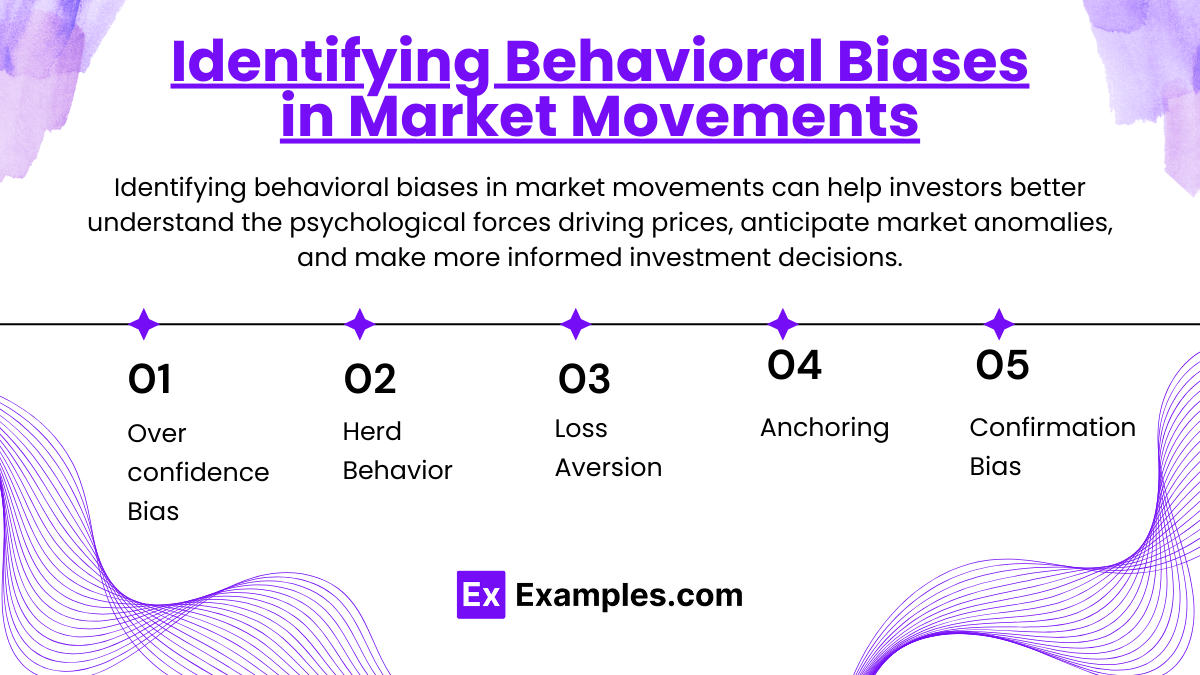
Identifying behavioral biases in market movements can help investors better understand the psychological forces driving prices, anticipate market anomalies, and make more informed investment decisions. Here are common behavioral biases and how they manifest in market movements:
1. Overconfidence Bias
- Manifestation in Market Movements: Overconfidence can drive high trading volumes and speculative activity, particularly in bull markets where investors feel overly optimistic. Excessive confidence in personal investing skills leads to more frequent trading, driving up stock prices as investors buy and sell based on perceived “insights” rather than fundamentals.
- Examples: During the dot-com bubble, overconfidence in tech stocks led investors to bid up prices without regard to actual earnings or business viability. Similarly, during cryptocurrency booms, investors often believe they “know” future price trends, resulting in sharp, speculative price increases.
2. Herd Behavior
- Manifestation in Market Movements: Herd behavior occurs when investors follow crowd actions rather than conducting independent analyses. It amplifies market trends, leading to bubbles as prices soar or crashes when they plummet. The desire to conform and fear of missing out (FOMO) often drive this behavior.
- Examples: Herd behavior was evident during the housing bubble in 2008, as buyers entered the market due to rising prices, leading to unsustainable growth. In recent years, meme stock rallies (such as GameStop) were also fueled by herd behavior, where retail investors bought stocks based on online forums rather than company fundamentals.
3. Loss Aversion
- Manifestation in Market Movements: Loss aversion leads investors to hold onto losing investments to avoid the pain of realizing a loss, hoping for a turnaround. This reluctance can delay the recognition of losses, prolonging the overvaluation of certain assets and contributing to price stickiness.
- Examples: During market downturns, investors often hold onto losing stocks instead of selling, which keeps prices from adjusting swiftly to realistic levels. Loss aversion was particularly evident after the 2000 tech crash, as many investors held onto declining tech stocks, hoping for a recovery.
4. Anchoring
- Manifestation in Market Movements: Anchoring occurs when investors focus on initial price levels or past highs as reference points, which can prevent timely re-evaluation of an asset’s worth. This bias leads to underreaction to new information or slow adjustments in response to changing fundamentals.
- Examples: After the 2008 financial crisis, many real estate investors anchored to pre-crash home values, which led to reluctance to adjust property prices to post-crisis conditions. Similarly, stock investors may hold onto a purchase price as an “anchor,” waiting for a stock to return to that level before selling, regardless of new information.
5. Confirmation Bias
- Manifestation in Market Movements: Confirmation bias leads investors to seek out information that supports their beliefs while ignoring contradictory evidence. This bias reinforces existing trends and can fuel bubbles as investors selectively absorb news that validates bullish or bearish outlooks.
- Examples: Investors in high-growth sectors, such as clean energy or technology, may focus only on optimistic projections and ignore potential risks, pushing prices higher than justified. This was seen in the run-up to the 2008 financial crisis, where many investors ignored signs of weakness in the housing market and focused on continued growth narratives.
Examples
Example 1: Positive Reinforcement
In behavioral therapy, positive reinforcement involves rewarding desirable behaviors to increase the likelihood of those behaviors being repeated. For example, a teacher might praise a student every time they complete their homework on time, reinforcing the behavior and encouraging the student to continue being punctual with assignments.
Example 2: Cognitive Behavioral Therapy (CBT)
CBT is a therapeutic approach that combines behavioral techniques with cognitive restructuring. It focuses on identifying and changing negative thought patterns and behaviors that contribute to emotional distress. For instance, a therapist might help a patient with anxiety recognize and challenge irrational fears, then replace them with healthier coping strategies to manage stress.
Example 3: Systematic Desensitization
This technique is often used to treat phobias or anxiety disorders. It involves gradually exposing a person to the feared object or situation in a controlled, systematic way while teaching relaxation techniques. Over time, the individual learns to associate the feared stimulus with calmness rather than anxiety, reducing their overall fear response.
Example 4: Shaping
Shaping involves reinforcing successive approximations of a target behavior. For example, when teaching a child how to tie their shoes, a parent might first reward the child for simply holding the laces, then reward them for making small loops, and eventually for completing the entire task. This gradual approach helps the child learn complex behaviors through smaller, achievable steps.
Example 5: Token Economy
In token economy systems, individuals are rewarded with tokens for exhibiting desirable behaviors, which can later be exchanged for a tangible reward or privilege. For example, in a classroom setting, students might earn tokens for good behavior (like completing assignments or participating in class) and trade them for rewards like extra playtime or a special privilege, promoting motivation and self-regulation.
Practice Questions
Question 1
Which of the following is an example of positive reinforcement in behavioral therapy?
A) Giving a child a time-out for misbehaving
B) Rewarding a student with extra playtime for completing their homework on time
C) Ignoring a child’s tantrum to decrease disruptive behavior
D) Using a punishment to discourage a bad habit
Correct Answer: B) Rewarding a student with extra playtime for completing their homework on time.
Explanation: Positive reinforcement involves giving a reward to increase the likelihood of a behavior being repeated. In this case, rewarding the student with extra playtime for completing their homework encourages them to continue completing assignments on time. Options A and D involve negative consequences (time-out and punishment), while option C focuses on ignoring behavior, which is not reinforcement.
Question 2
Which behavioral technique is most commonly used to help individuals overcome a specific fear or phobia?
A) Shaping
B) Positive reinforcement
C) Systematic desensitization
D) Token economy
Correct Answer: C) Systematic desensitization.
Explanation: Systematic desensitization is a gradual process where individuals are exposed to the source of their fear in a controlled way while practicing relaxation techniques to reduce anxiety. This technique is particularly effective for phobias. Shaping, positive reinforcement, and token economy are useful for modifying other behaviors, but they are not specifically designed to treat phobias.
Question 3
What is the main principle behind the shaping technique in behavioral therapy?
A) Reinforcing the final behavior only
B) Reinforcing closer and closer approximations of the desired behavior
C) Ignoring undesirable behavior to make it disappear
D) Using punishment to decrease undesired behaviors
Correct Answer: B) Reinforcing closer and closer approximations of the desired behavior.
Explanation: Shaping involves rewarding incremental steps toward the target behavior. For example, if teaching a child to ride a bike, the child might first be rewarded for simply getting on the bike, then for pedaling a few times, and eventually for riding without help. This technique encourages the gradual learning of complex behaviors by reinforcing small steps.

